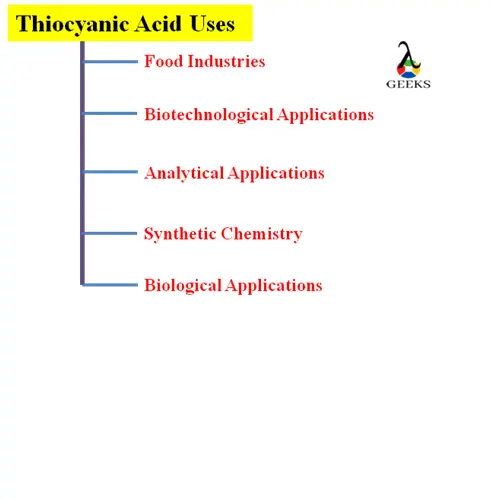Thiocyanic Acid is a chemical compound having molecular formula HSCN and molecular mass 59.09g/mol. Let us now gather more insight about this compound.
Thiocyanic Acid uses are listed below-,
- Food Industries
- Biotechnological Applications
- Analytical Applications
- Synthetic Chemistry
- Biological Applications
Let us have a look into the different properties and uses of Thiocyanic acid in detail in this Article.
Food Industries
- HSCN acts as an antibacterial reagent in milk and other products based on it.
- HSCN can be used as a preservative in certain food items.
Biotechnological Applications
- HSCN can be used as a biomarker.
- HSCN acts as a substrate in synthesizing different biological compounds.
Analytical Applications
- HSCN helps in better resolution of chiral compounds.
- HSCN improves the chromatographic response of enantiomers.
- HSCN can be used in determination of metals in organic-acetone phase.
Synthetic Chemistry
- HSCN is used for the preparation of substituted norbornyl systems.
- HSCN forms thiohydantoins from amino acids at room temperature and in short span of time.
- HSCN donates a hydron to an acceptor (bronsted base) unit.
- HSCN undergoes cycloaddition reactions forming different pericyclic products.
Biological Applications
- HSCN can be used as a metabolite.
- HSCN derivatives help in understanding the biological function of several biological enzymes.

Conclusion
HSCN is a highly useful compound based on its structure and properties. It is a hydracid and has numerous applications in biological, synthetic and analytical chemistry. Different derivatives can also be prepared from it and used further for different applications.

Hello…..I am Dr. Ankita Upadhyay, Research is my passion and I like to learn and share new facts related to chemistry and related areas. Writing is my new hobby and teaching is my profession. Always eager in seeking means and ways to pass on what I have learned now academically I end up having something on my plate always.